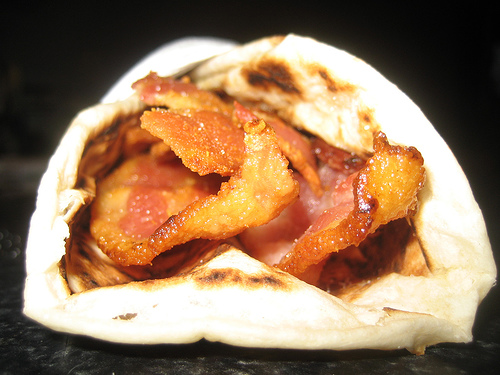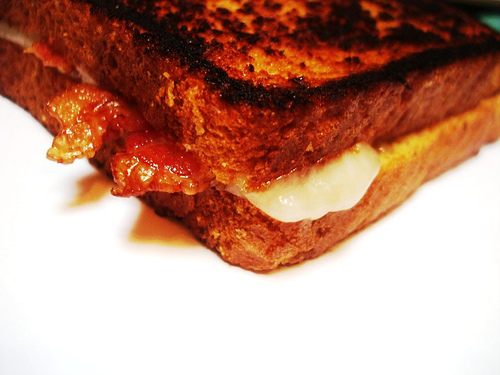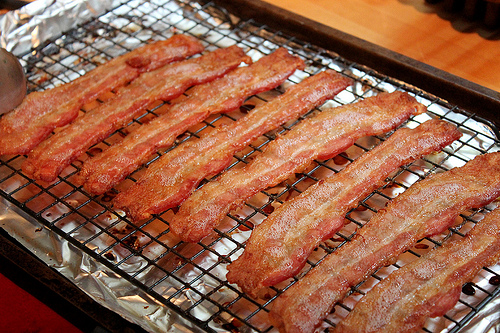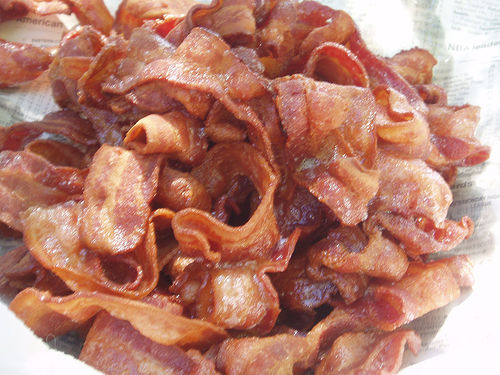
The internet has its fads, and bacon is one of the most enduring. You can buy bacon everything; candles, doughnuts, candy canes, gum, even soda. (Bacon mania is so entrenched in our culture that it even has its own separate Wikipedia page.)
It's pretty easy to make something bacon flavored. Just add smoke flavor and a lot of salt. The actual bacon is a little more tricky, though.

Image courtesy Flickr/PetersPics924
Bacon health hazards
Bacon is high in both salt and fat (duh) so those who are watching their intake of either substance will want to curb their bacon intake to the minimum.
But even aside from the obvious health risks, there are some rather disturbing (and so far unexplained) correlations between bacon and health problems. Highly processed meats (like bacon) are linked to chronic obstructive pulmonary disease (COPD), heart disease, and diabetes. Researchers believe the problem may be linked to the chemical preservative sodium nitrite.
All of which is to say that bacon is probably fine as an occasional treat, but may not be the best choice for a daily diet. Too bad!

Image courtesy Flickr/Darwin Bell
Where does bacon come from?
In America, bacon is made from the belly of the pig. This cut of meat is heavily streaked with fat. (Incidentally, this is why chefs go crazy over pork belly: it's basically just bacon that hasn't been sliced and cured yet.)
Bacon is cured in brine, and then often smoked to add more flavor. All this preparation adds to the cost of bacon, which can get fairly expensive per pound. But despite the preparation, bacon still needs to be cooked before being eaten.

Image courtesy Flickr/jcolman
What's the best way to cook bacon?
Most home chefs cook bacon in a skillet on the stovetop. A few minutes each side and you're done, although left with a (delicious) puddle of bacon fat.
I have a visual system for cooking bacon in a skillet: I cook it on one side until the sizzle starts turning a little bit foamy, flip it once, and cook it on the other side until it starts to foam. The "foam" is not very pronounced, it's actually fairly subtle. But you'll spot it if you're looking for it. Not to brag, but this method cooks bacon just right: not too crispy, and not too rubbery.
Another benefit to cooking bacon in a skillet is that you can then use it to cook eggs. This is how my grandmother made fried eggs: first you cook bacon, then (without turning off the heat) remove the bacon from the pan and crack eggs straight into the rendered bacon fat. It's salty and delicious, but maybe not super healthy.

Image courtesy Flickr/Dinner Series
However, professional kitchens forego this labor-intensive and messy process, and bake their bacon in the oven. Just line a cookie sheet with aluminum foil, lay out the strips of bacon, and bake it at 400 degrees until cooked (about 15-20 minutes).
If you want your bacon even crispier, you can lay it out on a roasting rack or a cookie cooling rack over the cookie sheet, so that the fat drips away from the bacon as it cooks.
What's the deal with bacon and chocolate?
The sweet/salty trend hit big with bacon. Bacon pairs surprisingly well with chocolate. Many people are familiar with pairing bacon and maple syrup (swirling it around on your plate when having pancakes for breakfast). This is the same deal.
The only problem is that bacon is fairly expensive, as an ingredient. Thus, most things use just a sprinkle of bacon pieces. This leads to concoctions which are much sweeter than they are salty, which is too bad.
Also, bacon and ice cream is kind of a bad idea, if you ask me. I tried that Burger King bacon sundae, and mostly what happened is that the fatty ends of the bacon get cold and icky in the ice cream. The crispy bits were okay, though.

Image courtesy Flickr/shawnzam
Using bacon
Quite a lot of bacon is consumed straight off the plate, no extra steps needed. Bacon is also a crucial ingredient in the BLT (for best results use iceberg lettuce and toasted white bread).
Due partly to its cost, bacon is usually used as an accessory. It can be added to cheeseburgers and grilled cheese sandwiches with great effect. It also makes an excellent topping for baked potatoes and salads.
If you want to go off the beaten path with your bacon, try cooking it wrapped around a hot dog, or weaving it into a mat! Woven bacon is the crowning glory of the legendary Bacon Explosion, and it makes an excellent wrap-around for a meatloaf.
Main image courtesy Flickr/cookbooman17

1 comments